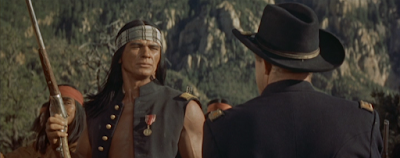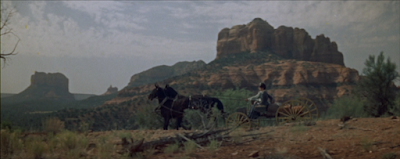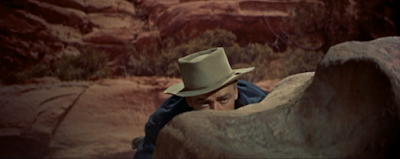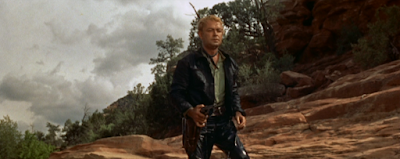Drum Beat is based around the Modoc War, an actual event in 1872-3 that took place in California and Oregon. A Modoc warrior called Captain Jack, or Kintpuash, led about 150 Modoc people off the Klamath Reservation. They evaded the US Army for quite some time, and the climax of this film seems like a pretty accurate portrayal of a real-life peace talk gone wrong. You can learn more about the actual events of the Modoc War here.
When we first see Johnny MacKay (Alan Ladd), he's outside the White House, wondering how to get in to see the President. He's gotten an invitation there, but he doesn't know how you're supposed to get inside.
It turns out the way to get inside to see President Grant (Hayden Rorke) is just to walk inside the White House and ask to see him. This kind of shocks MacKay, as he was expecting there to be a lot more pomp involved. It kind of shocks modern viewers too.
President Grant and his wife and daughter are entertaining a few people that evening, including Miss Nancy Meek (Audrey Dalton) and Dr. Thomas (Richard Gaines). MacKay's arrival is perfectly timed because Dr. Thomas is here to plead the case of some renegade Modoc warriors who have left their reservation and are threatening settlers. Dr. Thomas is convinced that these warriors are just high spirited, and that they pose no real threat. Nancy is happy to hear this, since she is planning to travel West to live with her uncle and aunt.
Johnny MacKay is completely skeptical about the Modoc renegades' intentions. He's been a scout and a guide all his life, negotiating with various American Indian tribes to gain safe passage for travelers and pioneers, and fighting against them when they refused. He also knows the leader of the renegades, Captain Jack. He thinks Dr. Thomas is a starry-eyed fool. But he understands why Nancy Meek might want to live in the West, as he loves it there.
Nancy Meek finds MacKay pretty fascinating, as you can see. It may help that he's wearing a gorgeous fringed buckskin jacket. I myself have a great weakness for those.
President Grant asks MacKay to be a peace commissioner and find a way to settle this Modoc uprising without bloodshed on either side. MacKay doesn't think he's the right man for the job, but Grant insists he's the only one respected by both the whites and the Modocs, and he has a better chance at brokering a peace deal than anyone else. Reluctantly, MacKay accepts. He's much less reluctant to accept the job of chaperoning Nancy Meek on her journey west :-)
The first time we see Captain Jack (Charles Bronson), he's also alone, but against a much different backdrop from the one where we first saw Johnny MacKay. They filmed the exteriors for this in Sedona, Arizona, and they are gorgeous.
Captain Jack (and, yes, I have a really hard time not typing "sparrow" after that name) is having a peaceful-so-far parlay with Colonel Meek (Richard H. Cutting), who is on his way to meet his niece Nancy at the stagecoach stop. Captain Jack argues with Colonel Meek over some medals Meek is wearing but won't give to Jack, but Colonel Meek is able to smooth things over and go on his way.
The stagecoach MacKay and Nancy Meek were on, driven by Bill Satterwhite, is attacked. Satterwhite's sweetheart is killed, and he goes off seeking vengeance. MacKay drives Nancy out to her uncle's ranch. The scenery they pass through is amazing, but they get more and more worried the closer they get without having met up with her uncle. Sure enough, tragedy has struck the ranch. Captain Jack wasn't so ready to give up on getting those medals from Colonel Meek after all.
MacKay takes Nancy back to the local Cavalry outpost, where he enlists the help of Captain Clark (George J. Lewis) and Lieutenant Goodsall (Peter Hansen) in meeting up with the friendly Modoc Indians who have not left the reservation. Maybe they can help protect settlers while MacKay figures out how to arrange some peace talks with Captain Jack the way the President wants.
The daughter and son of the last Modoc chief, Toby (Marisa Pavan) and Manok (Anthony Caruso), arrange to take MacKay to one of Captain Jack's strongholds.
There's no reason for this picture to be here except that it is so breathtakingly beautiful I can't leave it out.
In order to meet with Captain Jack, MacKay must climb up onto the top of a half-sunken structure, then climb down inside through a hole in the roof. Toby and Manok think this is a trap, but MacKay knows he has to show Captain Jack he's not afraid if Jack will respect him at all, so in he goes.
This is my favorite scene in the movie. Jack and MacKay face off, measuring each other, testing each other with words, each trying to find a weakness in the other. All while being as calm and cool as possible.
They both do a lot with body language, which I find really fascinating. MacKay starts out with his hands on his hips, looking down at the seated Captain Jack. Captain Jack is quite still for most of the scene, only shifting his position once in a while, while MacKay walks around, gestures to the assembled crowd, and overall tries to act as comfortable as possible.
Eventually, MacKay sits down, casual and calm, and they get down to talking man-to-man instead of appealing to the crowd.
Captain Jack agrees to think about peace. You'll notice that there is only one scene in this film where Captain Jack wears sleeves. The filmmakers weren't about to let Charles Bronson's magnificent arms go to waste. Which I appreciate.
Unfortunately, right as MacKay leaves this talk with Captain Jack, someone shoots a Modoc warrior in retaliation for a recent attack on a stagecoach. This infuriates the Modoc renegades, and they go on a killing spree.
Captain Jack and his followers take refuge in an almost impregnable mountain fortress, which is just gorgeous, isn't it? Also, there are actually stunt guys climbing those ladders. Yikes.
Manok and Toby convince Captain Jack to discuss peace with some representatives of the US government. Again. They're really brave, these two, risking their own lives again and again on behalf of the white people.
MacKay advises the Cavalry on how to proceed. This picture is mostly here for the nice way Alan Ladd is leeeeeaning on that railing.
We have a couple of thrilling skirmishes between the Modoc warriors and the Cavalry soldiers. It seems like Captain Jack's stone fortress is impregnable, and he'll be able to just keep burning ranches and killing settlers with impunity for as long as he likes. So much for that peace MacKay is supposed to be arranging on the President's behest.
Meanwhile, MacKay and Nancy Meek have been encountering each other pretty often since she's still living at the fort. A mutual fondness has sprung up.
They take a stroll together one evening, and end up sitting on a river bank discussing serious facts about the future. This is my other favorite scene because... it doesn't get sappy. Both characters are quite straight-forward about their attraction to each other AND the danger and problems that surround them.
They don't try to disguise the age gap between the actors playing these characters, either. Ladd was 41 and Dalton was 20, and so she plays Nancy as more hopeful and playful, while he's the experienced and somewhat weary one. He's a little reserved toward her, but her enthusiasm is infectious, and they both start to think maybe a relationship between them would work out. You know, if they manage to live through this whole situation with the Modoc renegades.
My favorite random tiny little thing about this whole movie is how they're just sitting there companionably by the water, and then Nancy just swings around and leans back against MacKay's upturned knee. It's very cute and sweet and playful, and it's not really a romancing set-up you see a lot in movies, so I just... am enchanted by it.
Clearly, MacKay is too. I mean, more flirty scenes should be staged like this. So cute.
And it so neatly facilitates a few smooches!
Anyway, the plot interrupts all that blossoming romance. Captain Jack has agreed to a peace talk with Johnny MacKay. He brings some warriors, and MacKay brings a general and his Modoc friends Toby and Manoc, plus that annoying Dr. Thomas from the beginning of the movie, who has come out here because he's sure Captain Jack and his followers are just misunderstood. They're really good and peaceable at heart.
Yeah, sure they are. What happens next is that peace-talk-gone-wrong I mentioned at the beginning, a real-life incident that left quite a few people dead on both sides.
So I really don't think it's a spoiler to tell you he's just wounded.
Slightly random aside, but this shot of MacKay peeking over a rock feels like a total callback to this shot of Alan Ladd in Whispering Smith (1948). It's probably just a coincidence. But maybe not.
Anyway, we all know this whole thing has to come down to a one-on-one fight between Captain Jack and Johnny MacKay. Which it does. They fight with guns and knives and fists in a long and glorious brawl that involves them both getting delightfully wet in that river you see here. Also, most of the wide shots look like it's really Bronson and Ladd flailing around in the river. Only a couple of the widest shots looked like doubles. Alan Ladd did love to swim and did as many of his own water stunts as the studios would stand for, so I guess I shouldn't be surprised.
Unfortunately, fights like that are hard to screencap, so I can only share this one shot from the end of a sopping wet Alan Ladd finally getting the upper hand. You'll just have to go watch it yourself to get the full effect, I guess.
In reality, several other leaders of the renegades were captured along with Captain Jack, but the movie streamlines it to just be him.
In real life, they tried and convicted all of the leaders, and a few were hung while the rest went to prison. In the movie, it's Captain Jack who's been convicted of murder and is awaiting hanging. He's very philosophical about his impending death, even kind of cheerful and charming. MacKay comes to talk to him in the stockade, and they part amicably.
The film ends with some beautiful shots of the peaceable Modocs riding beside a lovely river, going about their lives.
As for Johnny MacKay and Nancy Meek, they are going about their lives too -- lives that will involve getting married and rebuilding her uncle's ranch. Awwww!
This has been my contribution to the Shades of Shane blogathon that I am hosting here all weekend. That event is all about celebrating other films by the people who acted in Shane (1953), and this movie has two of them: Alan Ladd and Elisha Cook Jr. Stop by to see all the other things people are contributing!








































Well, this makes me want to try this movie again. I see from my movies-watched data base that it's been juuuust long enough since the last time I could possibly justify it...
ReplyDeleteVT, it's one I watched probably four years ago for the first time, and that was long enough to remember basics but not specifics, which made it very fun to revisit :-)
DeleteThanks for the review – I like Delmer Daves westerns. Daves usually both wrote and directed his films and I think he is vastly underrated (in the process of getting "rediscovered" now, I hear). He made some great ones with Glenn Ford (3:10 to Yuma (starring also Shane's Van Heflin, of course), Jubal) and one I particularly like, "The Last Wagon" with Richard Widmark. Yep, I think Ladd and Bronson did that "flailing around in the river" scene mostly without stunt doubles. All the more remarkable, since just before leaving for location in Arizona, accident-prone Ladd slipped in the shower, injured his back and cracked a rib. (Man, that guy was even more accident prone than I am...) Which led Louella Parsons to remark "Never heard of anyone having as many accidents as Alan Ladd".
ReplyDeleteAndrea, yes! Delmer Daves did some very good westerns. I haven't seen The Last Wagon, but I know the others you mentioned, and love 3:10 to Yuma very much.
DeleteI'm klutzy myself, so I find Ladd's tendency to get injured in the most random ways very endearing :-) I sympathize very much with that!
I am amused that it was filmed in Arizona (though not surprised), as I've been to the Lava Beds National Monument, where Captain Jack went. It's one of my favorite places, so cool to visit and explore all the lava tubes. I remember reading about him there.
ReplyDeleteThis looks like a fun movie that I need to see some time! For Charles Bronson's arms if nothing else, LOL!
ACK! Why did I never get notified about all these comments? Sigh. Blogger is so glitchy with the comments lately.
DeleteDKoren, it's kind of funny that, finally, they have a western that actually takes place in and around California... so they film it in Arizona. I mean... whatever, but still...
That's very cool you've been to the real Lava Beds! And, yes, we should watch this one together. Bronson's arms make it very worth the price of admission.
From your write-up I could easily visualize this, after seeing it at least 3 times, in a cinema,on dvd and tv a long time ago. It is one of my favourite 'indian fighter' movies. One of best from Delmer Daves! Charles Bronson caught my attention hereon. Thank you for this as I believe no one has done a review of this very underrated Ladd's western.
ReplyDeleteChrisk, I'm glad you enjoyed this! Bronson definitely catches one's attention here -- he's got a lot of edgy energy.
DeleteI haven't seen any other reviews of this one, but I bet if anyone has reviewed it, Laura's Miscellaneous Musings has, as she also appreciates Ladd and westerns.
Very interesting review! I'm sorry, but as soon as I read that sentence about Jack Sparrow I had to stop myself from thinking it. Thanks again for hosting this blogathon--it was great!
ReplyDeleteRebecca, lol! Imagining a '50s version of Pirates of the Caribbean with Bronson as Captain Jack Sparrow is not a bad way to spend one's time...
Delete